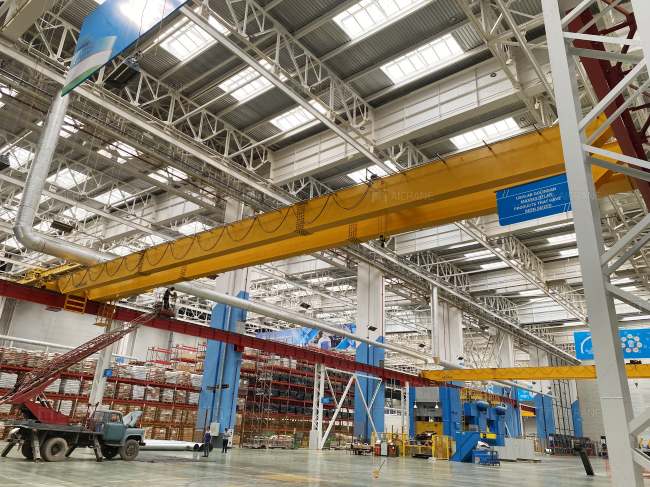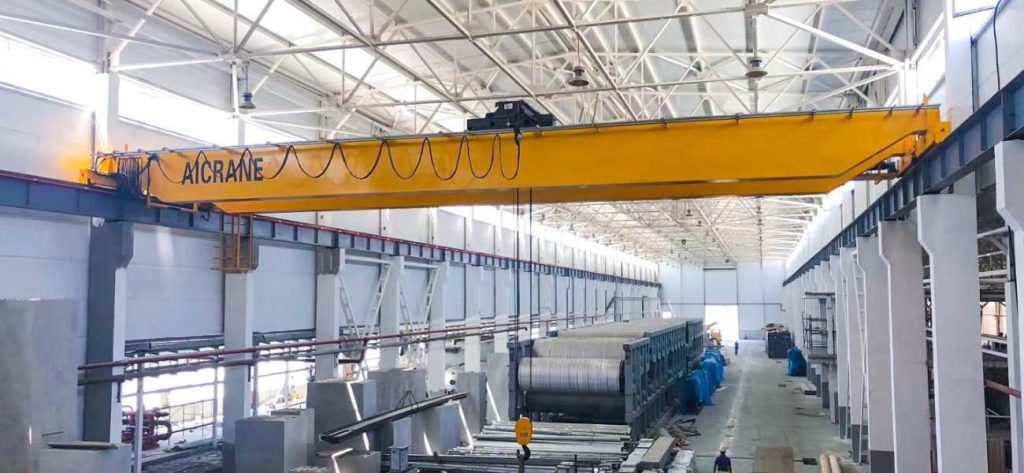In the fast-paced world of logistics and warehousing, efficiency, precision, and safety are paramount. As industries evolve, the demand for innovative solutions that streamline operations and optimize space usage continues to grow. Electric overhead travelling cranes (EOT cranes) have emerged as a crucial component in modern logistics and storage systems, offering a blend of technological advancements, robust performance, and operational versatility. This article explores how electric overhead travelling cranes enhance logistics and storage, driving productivity and efficiency across various sectors.

What are Electric Overhead Travelling Cranes?
Electric overhead travelling cranes are a type of material handling equipment designed to lift, lower, and transport heavy loads horizontally across a facility. They consist of a bridge that spans the width of the warehouse or facility, a hoist that lifts and lowers the load, and a trolley that moves the hoist along the bridge. The entire assembly travels on tracks mounted on the building’s support structure, enabling it to cover large areas efficiently.
EOT cranes are widely used in various industries, including manufacturing, warehousing, logistics, automotive, and construction, to handle heavy materials and products. Their ability to move large and heavy loads with precision and control makes them indispensable in environments where space optimization and efficient material handling are critical.
Advantages of Electric Overhead Travelling Cranes
Enhanced Efficiency
One of the primary benefits of EOT cranes is their ability to enhance operational efficiency. These cranes can move heavy loads quickly and accurately, reducing the time required for material handling tasks. This efficiency is particularly valuable in logistics and storage environments where timely movement of goods is essential to maintain workflow and meet delivery schedules. Eot cranes can be single girder or double girder overhead cranes to meet specific lifting needs.
Space Optimization
EOT cranes are designed to utilize vertical and horizontal space effectively. Unlike ground-based material handling equipment that requires dedicated floor space, EOT cranes operate overhead, freeing up valuable floor space for storage and other activities. This vertical integration allows warehouses to maximize their storage capacity by utilizing high shelves and racks, ultimately improving space utilization and reducing the need for facility expansion.
Precision and Control
Modern EOT cranes are equipped with advanced control systems that offer precise handling capabilities. Variable frequency drives (VFDs) and programmable logic controllers (PLCs) enable smooth acceleration and deceleration, reducing the risk of load swings and ensuring accurate positioning. This level of precision is crucial for tasks that require delicate handling, such as placing items on high shelves or stacking fragile goods.
Safety
Safety is a critical concern in material handling operations, and EOT cranes are designed with numerous safety features to protect both personnel and equipment. These features include:
- Anti-collision systems: Prevent cranes from colliding with each other or with obstacles in the facility.
- Overload protection: Ensures that the crane does not lift loads beyond its rated capacity, preventing mechanical failures.
- Emergency stop functions: Allow operators to halt overhead crane operations instantly in case of an emergency.
- Redundant braking systems: Provide additional braking capability to stop the crane safely in case of primary brake failure.
These safety features contribute to a safer working environment, reducing the risk of accidents and equipment damage.
Versatility
EOT cranes are highly versatile and can be customized to meet the specific needs of different industries. Manufacturers offer a range of options, including various lifting capacities, spans, and heights, to suit various applications. Additionally, specialized attachments and accessories, such as magnetic lifters, grab buckets, and spreader beams, can be added to enhance the crane’s functionality for specific tasks. There are many crane manufacturers providing overhead cranes, including Aicrane group, different cranes are customized to suit various materials handling requirements.

Technological Advancements
Automation and Smart Technology
The integration of automation and smart technology is revolutionizing the functionality of EOT cranes. Automated cranes, equipped with sensors and control algorithms, can perform lifting tasks autonomously, reducing the need for manual intervention. These smart cranes can optimize their movements based on real-time data, improving efficiency and safety.
The use of the Internet of Things (IoT) in crane operations allows for continuous monitoring and data collection. This data can be analyzed to predict maintenance needs, optimize workflows, and enhance overall performance. For example, smart cranes can adjust their lifting speeds and routes based on the weight and dimensions of the load, ensuring efficient and safe operations.
Energy Efficiency
Energy efficiency is becoming increasingly important in industrial operations. EOT cranes are being designed with energy-efficient components, such as VFDs and regenerative braking systems. VFDs optimize motor performance by adjusting speed and torque to match the load, resulting in significant energy savings. Regenerative braking systems capture and reuse energy that would otherwise be lost during braking, further enhancing efficiency.
Enhanced User Interfaces
Modern EOT cranes feature advanced user interfaces that improve ease of use and operator comfort. Remote control systems allow operators to manage crane operations from a safe distance, reducing exposure to hazardous environments. Touchscreen interfaces and intuitive control panels make it easier for operators to control crane movements precisely, enhancing productivity and safety.
Practical Applications in Logistics and Storage
Inventory Management
EOT cranes play a crucial role in efficient inventory management. Their ability to lift and move heavy items quickly and accurately enables warehouses to maintain optimal inventory levels and reduce handling times. This is particularly important in just-in-time (JIT) inventory systems, where timely material handling is critical to meeting production schedules.
Loading and Unloading
In logistics centers and warehouses, the loading and unloading of trucks, containers, and railcars are routine tasks. EOT cranes streamline these processes by providing the capability to lift and transfer heavy loads swiftly and safely. This efficiency reduces turnaround times for incoming and outgoing shipments, enhancing overall supply chain performance.
Heavy Machinery Handling
Warehouses that store or service heavy machinery, such as construction equipment or industrial machines, require robust lifting solutions. EOT cranes are ideally suited for these applications, offering the strength and stability needed to handle heavy and awkwardly shaped machinery. Their precision control ensures that these valuable assets are moved and positioned without damage.
Customization for Specific Needs
EOT cranes can be customized to meet the specific needs of different warehousing operations. Manufacturers offer a range of options, including different lifting capacities, spans, and heights, to suit various applications. Additionally, specialized attachments and accessories, such as magnetic lifters, grab buckets, and spreader beams, can be added to enhance the crane’s functionality for specific tasks.
Electric overhead travelling cranes are essential in modern logistics and storage, offering a combination of high load capacity, extended reach, enhanced stability, and precise control. Their ability to optimize space, improve safety, and integrate with advanced technologies makes them a critical component of efficient and productive warehouse operations. As technology continues to advance, EOT cranes will play an increasingly vital role in meeting the evolving demands of industrial lifting and material handling. For warehouses looking to stay competitive and efficient, investing in EOT crane systems is a strategic decision that promises substantial long-term benefits.